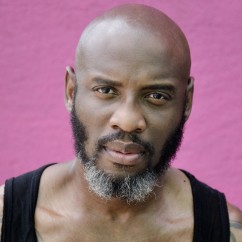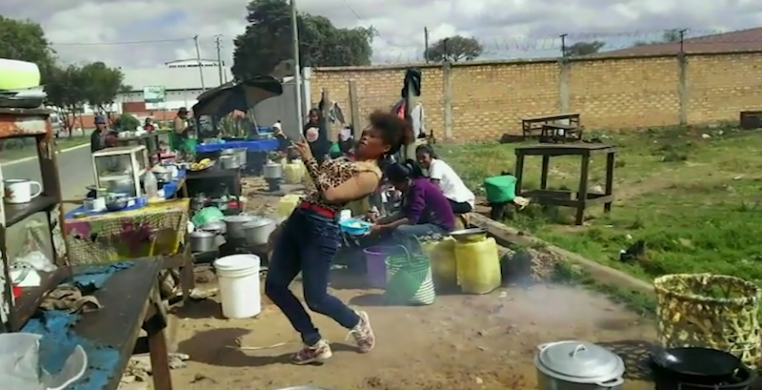CAMERA ROLLING…ACTION!
COVID-19 shifted norms for many, including how theatre goers experience live performances. Lliane Loots, artistic director of the JOMBA! Contemporary Dance Experience, introduced the 2020 JOMBA! Digital Fringe by fervently reminding us that the platform promotes new voices, offering less “seasoned” choreographers opportunities to present their works on a professional stage.
Loots indicated that even with the challenges and limitations a global pandemic triggered, JOMBA! still wanted to promote works by artists who rely on their platform for exposure. For that reason, they asked young and emerging artists to propose digital works for the festival instead.
To narrow the pool of well-deserving submissions, JOMBA! relied on the expertise of three renowned artists—Tiny Mungwe (Cape Town), Smangaliso Ngwenya (Johannesburg), and David April (Johannesburg)— to sift through the proposals, selecting the top eight. From those selected, three finalists would then receive small cash prizes recognizing their achievements.
The eight works selected ranged from personal narratives to themes centering on sociopolitical issues. Each piece had a kiss of desperation, not as it pertains to hopelessness, but from a solemnity to reveal what months of quarantining and social distancing generated; the need to reimagine creative ways of art making as they told their stories.
Of the eight pieces, four stood out…but three stuck with me.
CUT…ACTION!
Julie Veronirina Iarisoa choreographed and danced in the celebratory “And during that time I was dancing….” A visual jigsaw puzzle moving from scene to scene, Iarisoa romped on the waterfront with a cast of non-participating launderers performing their domestic tasks in the background. Iarisoa ignored the stares of curious onlookers on a busy street as she spread her arms, extended her leg away from her body and spun around herself before she leapt. Iarisoa represented disruption as she bopped alongside a man wheeling a barrel of green bananas and wiggled behind pots and pans in a marketplace. From site to site, she generated her own joy as the echoes of wind, water, honking motor vehicles, the banging of industrial tools and conversations in the background served as her soundscape. Iarisoa boogied and boogied…and she boogied ecstatically–a much appreciated expression as Black and brown unarmed men and women continue to be assassinated in the United States from where I watch her. Iarisoa’s dance beguiled me. And for two minutes and 13 seconds, I gave myself permission to exist in bliss, enjoying her delight.
CUT…ACTION!
The sound of snapping fingers, or maybe shutters, called out to me in short, sharp interludes. That was the music choreographer and performer Phumlani Life Mndebele reacted to as he stood with his hands on a white wall, activating every molecule in his body, moving slowly from side to side. Mndebele was in the corner of a room with his back toward the audience; his body silently spoke to me. Donning black shorts and with a tightened fist, Mndebele pulled his elbows behind him, deepening his stance. He exaggerated the expansion of his torso, as he morphed outward, then back into himself. He had the presence of a warrior, using his body as a weapon—and a shield. Every turn of the head and contraction of the torso felt like a reaction to the room, as if he were caged.
No Black man reacts joyously to the idea of being caged.
Titled “Thirst,” Mndebele’s percussive actions, tempered and decisive, appear as if he’s choosing if or how to react. Extant in that white stony room, his Black body flaunted rebelliousness. I found myself leaning into the reality that the Black male body has for long been gazed upon, exoticized and fetishized by the colonizers, even when it’s feared.
I felt guilty. Guilty because I too was subjecting him to those relegations with my lazy contemplations. I looked past his flesh…still watching. Mndebele used his hands to palpate the wall as if he were trying to find the unmarked space on its surface that would release him, but it never did. He turned, falling into the wall, and then he was still. The only proof of his efforts were his swollen body as he breathed.
CUT...ACTION!
Since my viewing of these works, three winners have been announced: Robert Ssempijja’s “The Myth of Self Isolation,” Sabelo Cele’s (Rea, “Leaze Chains” and Pavishen Paideya’s Aham “I Am…” They are accolade-worthy, well-conceived works. And although Ssempijja’s, “The Myth of Self Isolation” was a luxuriously victorious commentary on COVID-19, Cele’s “Leaze Chains” spoke to me the loudest, as his gift planted itself in my consciousness and stayed.
His narrative offered white chains. White writings on his Black body. Whiteness.
The words sexuality, alone, unleash, acceptance and poverty, appeared permanent—harrowing visuals. But the white writings and the white chains were no match for Cele’s physical urgency. He writhed as if in agony, contorting his body to liberate himself from the shackles of this constraint. He placed the seemingly weighted manacles on his neck, creating a flatback with his labored torso. He didn’t buckle; he didn’t fall. Cele was in control. The despotic words painted across his body reminded me of the constructed narrative of whiteness. And even as a construct, it remains oppressive.
CUT…CREDITS ROLLING!
The adjudicators selected a range of works that revealed inequities, celebrated life, existed in Blackness and honored traditions. COVID-19 has forced us to be distant, but it also hatched new voices—new digital voices. If the Digital JOMBA! Fringe taught us anything, it’s that our bodies are walking storytellers, both on and off screen.
The curation of this Digital Fringe was a testament to the possibilities—even in quarantine.
--
This piece was produced as part of the inaugural See Chicago Dance Critical Writing Fellowship in partnership with JOMBA! Contemporary Dance Experience and the University of KwaZulu-Natal (Durban, South Africa), the University of the Witwatersrand and The Ar(t)chive (Johannesburg, South Africa) and the University of East London (London, UK). Financial support is provided by the U.S. Consulate in Durban, the National Endowment for the Arts and the Chicago Department of Cultural Affairs and Special Events.

Fellow Gregory King is a culturally-responsive educator, performance artist, activist and movement maker who received his MFA in choreographic practice and theory from Southern Methodist University, and is certified in Elementary Labanotation from the Dance Notation Bureau. His dance training began at the Washington Ballet and continued at American University and Dance Theatre of Harlem. He has participated in the Horton Project in conjunction with the Library of Congress and has performed with Rebecca Kelly Ballet, The Washington Ballet, Erick Hawkins Dance Company, New York Theatre Ballet, Donald Byrd /The Group, The Metropolitan Opera Ballet, New York City Opera and Disney’s The Lion King on Broadway.
As a choreographer his works have been commissioned by Transformer Station (Cleveland, OH), Georgian Court University (Lakewood, NY), Texas Ballet Theatre School (Dallas, TX), Indiana University (Bloomington, IN), The Ammerman Center for Arts and Technology 16 Biennial Symposium (New London, CT), Current Sessions (New York, NY) and SPACES Gallery (Cleveland, OH), and presented at Dixon Place (New York, NY), The Kennedy Center (Washington D.C.) and Playhouse Square (Cleveland, OH).
He has taught master classes, lectures, and workshops nationally and internationally. He has served as dance faculty for Texas Ballet Theatre and Boston Ballet, as well as visiting assistant professor of dance at Temple University and Swarthmore College.
King is a dance writer for The Dance Enthusiast, ThINKingDANCE, The Philadelphia Dance Journal, CHOICE Review and Broad Street Review. Recently, Mr. King’s response to the Dancing for Justice Philadelphia event and was cited in the U. S. Department of Arts and Culture’s new resource guide, “Art Became the Oxygen.”
In addition to having served on the dance review board for the National Endowment for the Arts, King was nominated for a Governor’s Award for the Arts in Ohio and was recently appointed to the Board of OhioDance. He was the 2018 recipient of the Outstanding Creative Contribution award from the Division of Diversity, Equity and Inclusion at Kent State University and served as Provost Faculty Associate for the academic year 2019-2020. Mr. King is a tenure track professor of dance at Kent State where he serves as the artistic director of the Kent Dance Ensemble. www.gregoryaking.com

